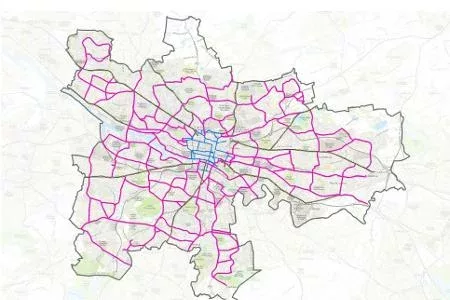Plans to build a City Network of active travel infrastructure for all parts of Glasgow have been approved by the council’s City Administration Committee.
Intended to support a crucial shift to walking, wheeling and cycling as part of the wider effort to reduce the city’s carbon footprint and improve air quality, the plans will add 270km of high-quality cycleways and improved footways along main roads in Glasgow.
The City Network is based upon a vision that active travel becomes the first choice for everyday journeys and will be designed to ensure easy access to safe, segregated routes from homes, schools, key amenities and cultural destinations throughout the city. It is planned that schools will be within 400m of the main active travel routes while no home is more than 800m from segregated cycling infrastructure.
Glasgow’s provision of segregated cycle ways has been expanding in recent years with initiatives such as the City Ways, Garscube Road as part of Connecting Woodside and the Avenues. The City Network will add to this infrastructure with the ultimate aim of ensuring that anyone who cycles will be able to reach most of the city within 30 minutes and almost all of the city within an hour. The strategy also emphasises the need for built environment to support walking and wheeling by removing barriers such as street clutter but also ensuring infrastructure such as pedestrian crossings and dropped kerbs are in place wherever necessary.
Councillor Anna Richardson, City Convener for Sustainability and Carbon Reduction, expressed her delight that the council had confirmed Active Travel Strategy as a cornerstone of Glasgow’s future transport provision. She sees the City Network of active travel infrastructure as the key to encouraging a widespread shift to walking, wheeling and cycling as the preferred mode of transport for increasing numbers of people.
Councillor Richardson said: “This is a huge step forward for active travel in Glasgow. Active travel must be an integral part of the city’s efforts to reduce transport-related carbon emissions. We now have a very clear way forward to increase the number of people who regard walking, wheeling or cycling as their first choice for everyday journeys.
“Safety is the number one reason for people being discouraged from using active travel and in particular, cycling. By having an active travel network of safe, segregated infrastructure that is easily accessible to every home and school across the city, we can provide a viable alternative for the millions of car journeys that are less than three kilometres. Reducing our reliance on private vehicles and encouraging a shift to the most sustainable forms of transport can make a major contribution to Glasgow’s effort to tackle climate change. “
It is intended the active travel strategy will sit alongside the council’s recent Liveable Neighbourhood’s Plan, which also seeks to reduce dependency on private cars by improving access to local centres and the range of services people rely upon on a daily basis.
The active travel strategy also provides a focus on training and education within schools but also looking to target groups that are under-represented or disengaged from walking and cycling. This will tackle the barriers that large numbers of older people, people at risk of deprivation and people from ethnic minority groups face to this cheap and healthy form of transport.
It estimated the envisaged network would cost an estimated £475m and work to engage with the Scottish Government has been underway on access to financial backing for the project. Several national funds have been identified that could potentially support the development of the City Network.




























